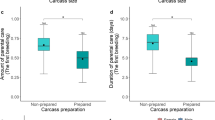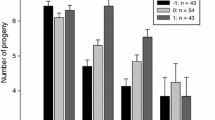Abstract
Lesser kestrels (Falco naumanni) lay clutches which appear excessive as only 3% of them yield as many young as eggs laid. Four hypotheses may explain the adaptive value of producing surplus eggs: (1) the bet-hedging hypothesis assumes that the environment varies unpredictably and surplus eggs serve to track uncertain resources; (2) the ice-box hypothesis suggests that surplus offspring serve as a reserve food during a period of shortage; (3) the progeny choice hypothesis says that parents produce surplus offspring in order to choose these with higher fitness; and (4) the insurance-egg hypothesis proposes that extra eggs are an insurance against the failure of any egg. To test the significance of this strategy in the lesser kestrel, an experiment manipu-lating brood size at hatching was carried out over 2 years, with good and bad feeding conditions. The experiment consisted of adding a chick to experimental broods where one egg failed to hatch or removing a randomly selected chick from experimental broods where all eggs had hatched. Independently of annual food availability, pairs with brood sizes reduced by one chick fledged more nestlings than pairs with brood size equalling their clutch sizes. Body condition of young was also better in the former group, but only in 1993 (a high-food year). Independently of year, mean local survival of parents with complete broods at hatching was lower than for parents raising reduced broods. These results supported only the insurance-egg hypothesis which says that surplus eggs may be an insurance against the failure of any egg, but parents may suffer reproductive costs when all eggs hatch.
Similar content being viewed by others
Author information
Authors and Affiliations
Additional information
Received: 17 January 1997 / Accepted after revision: 27 April 1997
Rights and permissions
About this article
Cite this article
Aparicio, J. Costs and benefits of surplus offspring in the lesser kestrel (Falco naumanni ). Behav Ecol Sociobiol 41, 129–137 (1997). https://doi.org/10.1007/s002650050372
Issue Date:
DOI: https://doi.org/10.1007/s002650050372




